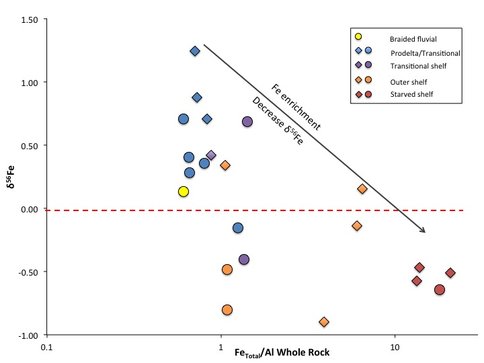2014 Annual Science Report
 University of Wisconsin
Reporting | SEP 2013 – DEC 2014
University of Wisconsin
Reporting | SEP 2013 – DEC 2014
Project 3D: A Microbial Iron Shuttle in Early Earth Marine Basins
Project Summary
Iron-based metabolisms are deeply rooted in the tree of life, and yet comparatively little attention has been paid to searching for Fe-based biosignatures as compared, for example, photosynthetically-based metabolisms. Dissimilatory Iron Reduction (DIR) is found in both Archaea and Bacteria domains of life, its electron acceptors and donors are widespread in the solar system. This project focuses on determining the basin-scale footprint of DIR in well preserved samples of Mesoarchean age (~3 Ga) in the Witwatersrand Supergroup of South Africa. Preliminary results show a trend of iron enrichment that correlates with δ56Fe depletion from the proximal shelf to the deep distal basin, which is interpreted to indicate a DIR-driven “iron pump” or “shuttle”, where microbially-produced aqueous Fe(II) on continental shelves was pumped to the deep basin and trapped as Fe-bearing sulfides or oxides. These results not only confirm that Fe-based metabolisms were important on the early Earth ~3 b.y. ago, but that it had a substantial “footprint” in the biosphere on a basin-wide scale.
Project Progress
Based on modern marine systems, it has been proposed that Dissimilatory Iron Reduction (DIR) may pump aqueous Fe(II), the product of DIR, on a basin-wide scale—a process termed a “benthic iron shuttle”. If a DIR-driven shuttle could be demonstrated to have operated in the deep Archean, this would, for the first time, demonstrate that DIR had a major footprint in the environment of the early Earth. DIR may produce distinct carbon and iron isotopic signatures that can be preserved in Fe (II)-bearing minerals such as magnetite and siderite (Johnson et al., 2008). In this project, we focused on the oldest well-preserved Archean basin known that allows comparison of shallow and deep basin sections the Mesoarchean Witwatersrand Supergroup. Analyses of microdrilled pyrite and bulk whole rocks were done, and as well as in situ analysis of magnetite. Additionally, these samples are representative of a complete depositional basin—from the proximal shelf to the deep basin. Preliminary results on Fe isotope compositions of microdrilled pyrite and whole-rock samples show a trend of increasingly light iron isotope signatures (decreasing δ56Fe) moving from the proximal to distal marine settings—in tandem with whole-rock Fe enrichment in the distal basin (Figure 1). In Severmann et al (2008)’s study of the Black Sea, a similar trend was observed. Measuring the Fe isotopes and concentrations of sediments across the basin, it was found that there was an inverse correlation between δ56Fe and the Fe/Al ratio of whole rock samples. This formed the basis for proposing the benthic iron shuttle, where reactive Fe produced by DIR is preferentially removed from the shelf and sequestered in the deeper depofacies (Figure 2). Sequestration of this benthic iron flux is required in order to observe a negative correlation between δ56Fe and whole rock iron content. In order to keep this iron in the distal basin, a trapping mechanism is required. In all previously studied benthic iron shuttles, this trapping mechanism is a water-column redox boundary, where the benthic iron flux is trapped below oxic surface waters in an anoxic or euxinic basin. Therefore, the expression of a benthic shuttle not only informs us about the microbial ecology of iron reducing microbes of this time, it could also imply an ephemeral oxidation of the Mesoarchean atmosphere.
The fractionation factor between aqueous Fe (II) and pyrite is very different from the fractionation factor between aqueous Fe (II) and iron oxides (Johnson et al., 2008). To produce whole-rock δ56Fe values that are similar to those for pyrite, as seen in preliminary data, is unexpected for equilibrium conditions, and suggests that pyrite was formed by sulfidation of iron oxides. This trend is also observed with in situ laser ablation MC-ICPMS on magnetite, where magnetite δ56Fe signatures similar to those obtained for microdrilled pyrite. This hypothesis, however, needs to be tested with further analyses to fully understand the pathways for Fe and what the sink mechanism is for the benthic iron shuttle. A key lithology that we will target is the extensive magnetic mudstones from the Witwatersrand Supergroup, given the fact that magnetite is a common end product of DIR. Preliminary results from Yamaguchi et al. (2005) identified negative δ56FeWhole Rock values for magnetic mudstones that may be a signature for DIR. We therefore hypothesize that the main sink for a benthic iron flux signature could be magnetite.
References Cited
Johnson, C. M., et al., 2008, Annu. Rev. Earth Planet. Sci., v. 36, p. 457-493.
Severmann et al., 2008, Geology, v. 36, p. 487-490.
-
PROJECT INVESTIGATORS:
-
PROJECT MEMBERS:
Clark Johnson
Project Investigator
Brian Beard
Co-Investigator
Nicholas Beukes
Collaborator
Bradley Guy
Collaborator
Breana Hashman
Collaborator
Shuhei Ono
Collaborator
-
RELATED OBJECTIVES:
Objective 4.1
Earth's early biosphere.
Objective 5.2
Co-evolution of microbial communities
Objective 6.1
Effects of environmental changes on microbial ecosystems
Objective 7.1
Biosignatures to be sought in Solar System materials
Objective 7.2
Biosignatures to be sought in nearby planetary systems

